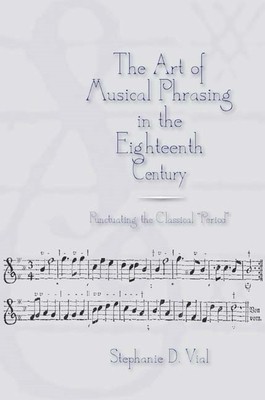
- We will send in 10–14 business days.
- Author: Stephanie Vial
- Publisher: University of Rochester Press
- ISBN-10: 1580460348
- ISBN-13: 9781580460347
- Format: 16.3 x 23.6 x 3.1 cm, kieti viršeliai
- Language: English
- SAVE -10% with code: EXTRA
The Art of Musical Phrasing in the Eighteenth Century (e-book) (used book) | bookbook.eu
Reviews
Description
Practical suggestions, and documentary evidence, for performers wishing to understand the gestures and nuances embedded in eighteenth-century musical notation.
There are, of course, no commas, periods, or question marks in music of the Baroque and Classic eras. Nonetheless, the concept of "punctuating" music into longer and shorter units of expression was richly explored by many of the era's leading composers, theorists, and performers. The Art of Musical Phrasing in the Eighteenth Century gathers and discusses, for the first time, an extensive collection of quotations and musical illustrations relevant tophrase articulation and written and unwritten rests. Among the notable authors cited and discussed are Muffat, Telemann, C. P. E. Bach, Mattheson, Marpurg, Tartini, and Mozart's father Leopold (author of the most important eighteenth-century treatise on string playing). On a larger scale, The Art of Musical Phrasing demonstrates the role of punctuation within the history of rhetoric during the Age of Enlightenment. From this, the performer of todaycan gain a greater appreciation for both the strengths and shortcomings of the analogy that writers of the day drew between punctuation in written language and in music.Modern performers, argues Vial, have the challenge andresponsibility of understanding and conveying the nuances, inflections, and rhythmic gestures deeply embedded in eighteenth-century musical notation. The Art of Musical Phrasing, the fruit of Vial's rich experience as a cellist performing on both period and modern instruments, lays out long-needed practical suggestions for achieving this goal. Stephanie D. Vial performs and records widely as a cellist and has taught at the University ofNorth Carolina at Chapel Hill and Duke University.
EXTRA 10 % discount with code: EXTRA
The promotion ends in 23d.17:07:27
The discount code is valid when purchasing from 10 €. Discounts do not stack.
- Author: Stephanie Vial
- Publisher: University of Rochester Press
- ISBN-10: 1580460348
- ISBN-13: 9781580460347
- Format: 16.3 x 23.6 x 3.1 cm, kieti viršeliai
- Language: English English
Practical suggestions, and documentary evidence, for performers wishing to understand the gestures and nuances embedded in eighteenth-century musical notation.
There are, of course, no commas, periods, or question marks in music of the Baroque and Classic eras. Nonetheless, the concept of "punctuating" music into longer and shorter units of expression was richly explored by many of the era's leading composers, theorists, and performers. The Art of Musical Phrasing in the Eighteenth Century gathers and discusses, for the first time, an extensive collection of quotations and musical illustrations relevant tophrase articulation and written and unwritten rests. Among the notable authors cited and discussed are Muffat, Telemann, C. P. E. Bach, Mattheson, Marpurg, Tartini, and Mozart's father Leopold (author of the most important eighteenth-century treatise on string playing). On a larger scale, The Art of Musical Phrasing demonstrates the role of punctuation within the history of rhetoric during the Age of Enlightenment. From this, the performer of todaycan gain a greater appreciation for both the strengths and shortcomings of the analogy that writers of the day drew between punctuation in written language and in music.Modern performers, argues Vial, have the challenge andresponsibility of understanding and conveying the nuances, inflections, and rhythmic gestures deeply embedded in eighteenth-century musical notation. The Art of Musical Phrasing, the fruit of Vial's rich experience as a cellist performing on both period and modern instruments, lays out long-needed practical suggestions for achieving this goal. Stephanie D. Vial performs and records widely as a cellist and has taught at the University ofNorth Carolina at Chapel Hill and Duke University.


Reviews